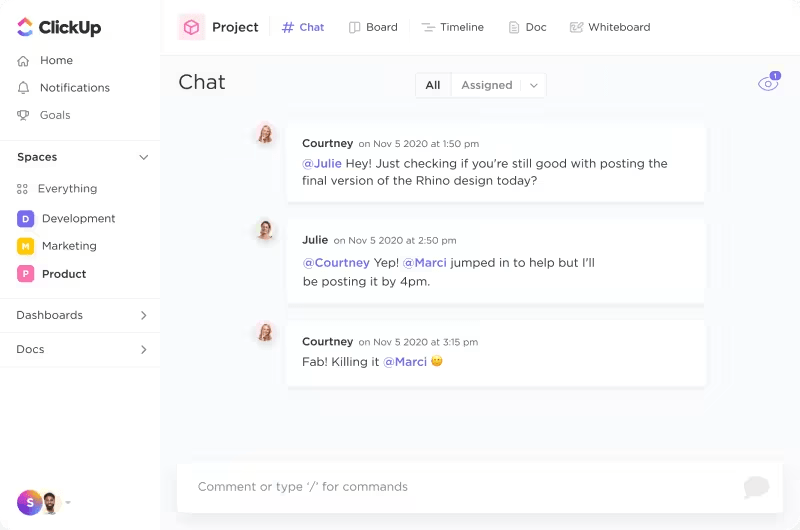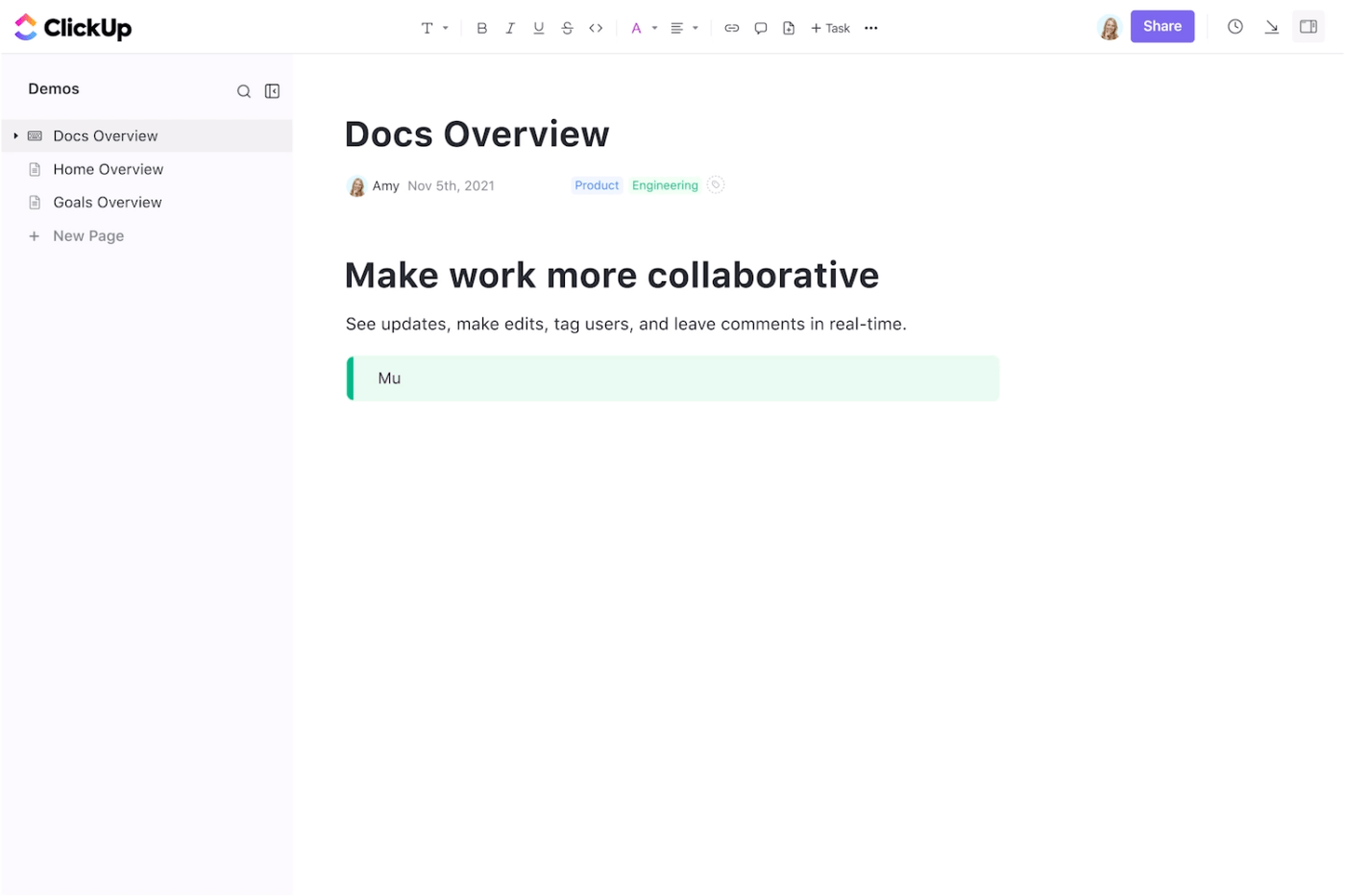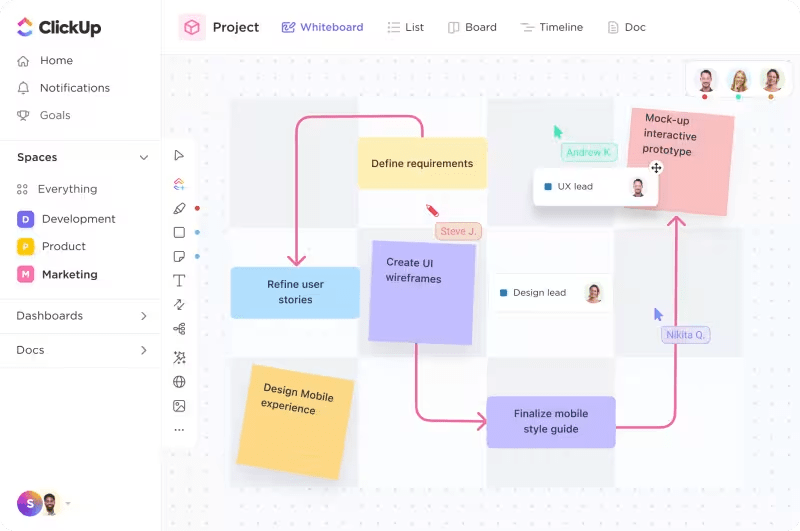إن قيادة أي فريق بفعالية هو تحدٍ كبير. وإدارة الفرق الإبداعية بشكل جيد هي لعبة مختلفة تماماً.
فما بين التعاون بين الفرق، وتطوير الأصول، والحصول على التأييد، وتنفيذ الملاحظات، وغير ذلك، غالبًا ما يكون لدى الموظفين المبدعين الكثير من العمل.
فهم يعملون في نقطة التقاء الاستراتيجية والإبداع لتخطيط وتصميم وتطوير وتنفيذ التسويق والإبداع، كما أنهم يعملون على تخطيط وتصميم وتطوير وتنفيذ مبادرات العلامات التجارية واحدة تلو الأخرى. وبطبيعة الحال، يجب عليهم أن يدفعوا باستمرار حدود الإبداع في الوقت الذي يواجهون فيه ضغوطًا للابتكار.
إنه ليس يوماً سهلاً أبداً في العمل بالنسبة للمبدعين!
لذا، كيف تدعمهم للحفاظ على إلهامهم والقيام بأفضل أعمالهم؟ كيف يمكنك إدارة التوقعات مع السماح للإبداع بالازدهار؟
سواء كنت تقود فريقًا داخليًا من المبدعين أو تقدم خدمات إبداعية للعديد من العملاء، يمكن أن تساعدك الاقتراحات والنصائح والنماذج التالية على إدارة الفرق الإبداعية بشكل أفضل.
هيكلة وقيادة الفرق الإبداعية
يكون الفريق الإبداعي جيداً بقدر جودة التآزر بين أعضائه. لضمان إعداد فريقك للنجاح، اتبع الخطوات التالية.
1. حدد الأدوار التي يجب توظيفها
عند اتخاذ قرار بشأن الأدوار التي يجب توظيفها، ضع في اعتبارك احتياجات العمل الفورية والثغرات في المهارات بين أعضاء الفريق الحاليين.
إذا كان فريقك صغيرًا، فمن الأفضل أن تختار المتخصصين الذين يمكنهم ارتداء قبعات متعددة. يمكنك البدء في توظيف المتخصصين عندما تبدأ في التوسع.
سيتضمن الهيكل المثالي للفريق الإبداعي الأدوار التالية:
- مدير مشروع/مدير فريق: يشرف على تنفيذ المشاريع، وينظم العمليات الإبداعية، ويعزز أداء الموظفين من خلال التغذية الراجعة
- خبير استراتيجي: يبحث وينفذ حملات تسويقية وإعلانية تتماشى مع احتياجات الجمهور المستهدف
- كاتب الإعلانات: ينشئ محتوى واضحًا ومتوافقًا مع العلامة التجارية لمختلف أنواع الوسائط وقنوات التسويق
- مصمم جرافيك:يحول الأفكار إلى مفاهيم بصرية جذابة لإعلام العملاء وجذبهم
- خبير العلامات التجارية: يقوم بتطوير ويدير هوية العلامة التجارية والسمعة لدفع عجلة النمو
- مطور ويب: يقوم ببناء تطبيقات الويب والمواقع الإلكترونية وترميزها وصيانتها
2. تحديد التسلسل الهرمي للفريق ومسؤولياته بوضوح
في حين أن الفريق الإبداعي الناجح يحتاج إلى مستوى معين من الاستقلالية للازدهار، فإنه يحتاج أيضًا إلى هيكل واضح لفهم تقسيم المسؤوليات.
سيؤدي وجود تسلسل هرمي واضح للفريق مع واجبات محددة بشكل جيد إلى تقليل النزاعات الداخلية وتعزيز ثقافة المساءلة حيث يمكن لزملاء الفريق إظهار الملكية بنشاط وإظهار الدافع للتفوق.
3. وضع عمليات وسير عمل واضحة
يمنحك سير العمل الإبداعي المحدد جيدًا مع عمليات مثبتة الثقة لك ولأعضاء فريقك لإكمال المهام في الوقت المحدد.
لذا، قم بتعيين وتوثيق جميع عملياتك وتوصيل المنهجية إلى أعضاء فريقك. وفي الوقت نفسه، اترك مساحة للتساؤل والفضول لمواصلة تحسين سير العمل.
لتبسيط العمليات الإبداعية، يجب أن تحدد عملياتك وسير عملك توقعات المشروع وعمليات الموافقة وأفضل الممارسات وحلقات التغذية الراجعة وغيرها من التعليمات.
4 نصائح لقيادة وإلهام فريق إبداعي بفعالية
توظيف الأشخاص المناسبين وبناء فريق إبداعي هو الخطوة الأولى فقط لإدارة المشاريع الإبداعية. يجب عليك العثور على نهج الإدارة الصحيح لجعل كل ذلك يتحقق. إليك بعض النصائح:
1. أشعل شرارة الإبداع لديهم
بصفتك المدير أو القائد الإبداعي، يقع عبء إلهام فريقك وتمكينه على عاتقك.
إذا تمكنت من مساعدة فريقك على فهم السبب الرئيسي وراء ما يفعلونه، يمكنك تحفيز التفكير الإبداعي وتحفيز زملائك في الفريق على تولي مسؤولية المبادرات الجديدة.
وبهذه الطريقة، ستعزز فريقًا من المبدعين الذين لا يخشون تحدي الوضع الراهن وإيجاد أفضل الحلول للمشاكل - بدلاً من مجرد القفز من مهمة إلى أخرى
2. إتقان فن التفويض
لا يمكن لشخص واحد القيام بكل شيء. سيحكم مصمم الجرافيك الخاص بك بشكل أفضل على محاذاة النص في منشورك على إنستغرام. وفي الوقت نفسه، قد يتفوق مدير وسائل التواصل الاجتماعي لديك في تحويل منشورات المدونة الطويلة إلى تعليقات اجتماعية واضحة.
إذا كنت ترغب في أن تكون مشاريعك الإبداعية مثالية، يجب عليك تفويض العمل إلى الأشخاص الذين يمكنهم القيام بذلك على أفضل وجه. قم بإشراك وتوجيه أعضاء الفريق من خلال توفير الأدوات والتوجيهات الصحيحة. وتأكد من فهمهم لتوقعات المشروع والاتفاق على المواعيد النهائية للمهمة الموكلة إليهم.
وبهذه الطريقة، يمكنك الاستفادة القصوى من المواهب المتاحة مع جعلهم يشعرون بالمشاركة وتعزيز ثقافة المساءلة - بدلاً من الضغط على الموارد أو إثقال كاهل زميل معين في الفريق.
3. ضمان التواصل اليومي للفريق
عند إدارة الأشخاص المبدعين، فإن التواصل اليومي أمر غير قابل للتفاوض. يمكنك جدولة تسجيلات الوصول 1:1 أو اجتماعات يومية مع جميع زملائك في الفريق لمناقشة المشاريع، وتقدم الأهداف، والتحديات.
سيضمن القيام بذلك أن يشعر كل عضو من أعضاء الفريق بأنه مسموع ويبقى تركيزه مستمراً ويفهم التوقعات جيداً.
هذه الجلسات اليومية رائعة أيضًا لتقدير زملائك في الفريق وتقديم التشجيع، مما سيساعدك حتمًا على تأسيس ثقافة عمل تعاونية.
حافظ دائماً على التواصل المفتوح عبر قنوات آمنة ويمكن الوصول إليها مثل Slack والبريد الإلكتروني.
4. اسمح للاستقلالية والمرونة بالازدهار
لن يكون لأي اثنين من المبدعين في الفريق نفس أسلوب العمل - ولن يعملوا بشكل خطي. لذا، عندما تفرض ساعات عمل صارمة, الجداول الزمنية للمشروع أو البروتوكولات، فإنك تقوم بإنشاء نقاط احتكاك دون علمك.
من خلال توفير المرونة في كيفية تعامل فريقك الإبداعي مع العمل والسماح لأعضاء فريقك بتولي المسؤولية من خلال الإدارة الذاتية، يمكنك تنمية ثقافة المساءلة والتعاون والثقة المتبادلة.
الأخطاء الشائعة أثناء إدارة فرق العمل الإبداعية
على الرغم من بذل قصارى جهدك لمواءمة أعضاء فريقك والحفاظ على سير العمليات الإبداعية بسلاسة، إلا أنك قد ترتكب بعض الأخطاء الشائعة.
ما هي هذه الأخطاء، وكيف يمكنك تجنبها؟ دعنا نكتشف ذلك.
الخطأ 1: عدم توجيه النقد البنّاء
عندما يكون النقد بنّاءً وسلبيًا ويفتقر إلى التحديد، ولا يقدم ما يكفي من الأسباب للضعف الذي تم تحديده، فهو ليس بنّاءً. على سبيل المثال، نقد مثل، "لا أعتقد أن المقدمة جيدة."
قد يبدو مثل هذا التعليق قاسيًا ويقلل من قدرات الفرد. علاوة على ذلك، إذا استمرت مثل هذه الممارسة دون رادع مع مرور الوقت، فقد يؤدي ذلك إلى تثبيط معنويات فريقك بشدة وخنق التفكير المستقل والإبداعي.
ومع ذلك، فإن النقد البناء سيسلط الضوء على إيجابيات العمل الإبداعي وسلبياته. كما سيقدم تفسيرات واضحة ومقترحات تحسينية لكل مشكلة يتم طرحها، مع تقديمها بتعاطف وتفهم.
على سبيل المثال، "بما أن الجمهور هو طلاب مرحلة الروضة حتى الصف الثاني عشر، يجب استخدام كلمات أبسط في المقدمة. يرجى إعادة الصياغة وفقًا لذلك. " هي أفضل التعليقات لأنها واضحة وقابلة للتنفيذ.
مجالات التحسين:
- استمع إلى وجهات نظر أعضاء الفريق أولاً: دعهم يشرحون نهجهم وتفكيرهم والعملية التي تقف وراء المخرجات الإبداعية. يمكن أن يساعدك ذلك على فهم الثغرات في فهمهم بشكل أفضل قبل تقديم الملاحظات
- كن مباشراً دون أن تكون جارحاً: كن موضوعياً وموجهاً عند معالجة الأخطاء التي ارتكبوها. أشر إلى ما يصلح وما لا يصلح مع اقتراح خطوات قابلة للتنفيذ
- اشرح تفكيرك باستمرار: عند تقديم النقد، قدم أسبابًا ومبررات منطقية لكل تعليق تبديه. بالإضافة إلى ذلك، احرص على ربط هذه المبررات بمشكلات تتعلق بفهم الجمهور أو احتياجات المشروع
الخطأ 2: عدم تقديم ملخصات إبداعية واضحة ومفصلة
وفقًا لـ تقرير ليثو للعمليات الإبداعية لعام 2023) أن 94% من أصحاب المصلحة يقولون إنهم يتواصلون بوضوح مع طلباتهم الإبداعية. ومع ذلك، يوافق 69% فقط من المبدعين على أنهم يفعلون ذلك. هذا الانفصال الواضح وعدم التطابق في الفهم ليس واضحًا كما هو الحال في حالة الملخصات الإبداعية.
يمكن للموجزات الإبداعية التي تفتقر إلى الوضوح أو التفاصيل أن تتسبب في تأخيرات غير ضرورية للمشروع، وتوتر علاقات العمل، وتكلف الموارد، وتتركك مع فريق من المبدعين غير راضٍ للغاية.
في المقابل، لا تريد أيضًا أن يكون الموجز مقيدًا للغاية مع إرشادات صارمة. شدد على التفاصيل الأساسية مثل رسالة العلامة التجارية ونبرة الصوت، ولكن اترك بعض المساحة للإبداع.
المفتاح هنا هو التوازن.
مجالات التحسين:
- تأكد من أن الموجز يغطي أهداف المشروع والجمهور المستهدف والجداول الزمنية والمقاييس بالتفصيل: يجب أن يحتوي على معلومات كاملة عن المشروع ليتمكن المبدعون من البدء بسرعة
- إضفاء الطابع النموذجي على عملية إنشاء الموجز: يضمن القيام بذلك تقديم جميع التفاصيل إلى الفريق بسرعة وبطريقة مبسطة. ما عليك سوى ملء تفاصيل المشروع فيقالب الموجز الإبداعيوستكون جاهزاً.
الخطأ الثالث: عدم توفير بيئة آمنة لازدهار التفكير الإبداعي المستقل
هل يقوم فريقك دائمًا بنفس الطريقة؟ إذن، هناك فرصة أكبر لتسلل الرداءة إلى مشاريعك.
فالفرق ذات العملية الإبداعية المحددة غالبًا ما تكبح التفكير التباعدي وتخنق الابتكار. ومما يزيد الطين بلة، أنه نظرًا لقلة أو انعدام التحدي بالنسبة للموظفين، يصبح العمل رتيبًا وغير متفاعل.
وهذا يخلق فقط موظفين يشعرون بالملل بسهولة ومن المرجح أن يستقيلوا.
مجالات التحسين:
- لا تتسرع في تثبيط الأفكار الخارجة عن المألوف: دع فريقك يركض مع الفكرة ويعود لإقناعك. إن إعطاء الموظفين الحرية لتجربة أشياء خارج الروتين سيجعلهم بارعين في حل المشاكل بطريقة مبتكرة
- وصفنطاق المشروع بوضوح: عندما يعرف أعضاء فريقك احتياجات المشروع وتوقعاته، سيتعلمون ممارسة الإبداع ضمن نطاق المشروع. سوف تضرب عصفورين بحجر واحد - ستضرب عصفورين بحجر واحد - حيث ستدعوهم إلى أفكار جديدة مثيرة للاهتمام وتوفر مساحة آمنة للموظفين للتفكير بشكل خلاق ومستقل
التحديات الشائعة التي تواجهها الفرق الإبداعية
فيما يلي ثلاثة من أكثر المزالق شيوعًا التي تواجهها الفرق الإبداعية:
السرعة التي من المتوقع أن تعمل بها الفرق الإبداعية
غالبًا ما يتم الضغط على معظم الفرق الإبداعية لتقديم عمل عالي الجودة ضمن مواعيد نهائية صارمة. ومع ذلك، فإن هذه التوقعات غير عادلة نظرًا للطبيعة غير الخطية والعشوائية للإبداع، والتي تعاني في البيئات سريعة الوتيرة.
يؤدي استخدام السرعة كمقياس أداء حاسم إلى خلق احتكاك غير ضروري ويقلل من جودة المخرجات. المقياس الأفضل هو جودة العمل المنتج.
نقص الموارد والطرق الفعالة لمواجهته
مع زيادة عدد قنوات التسويق، تزداد الحاجة إلى الموارد الإبداعية. ولسوء الحظ، لا تحظى جميع فرق العمل بالموظفين أو الدعم الكافي، مما يعني أن المبدعين يرتدون قبعات متعددة.
يمكنك تجنب ذلك من خلال التخطيط الفعال للموارد وتفويض العمل. قالب خطة المشروع الإبداعي الخاص ب ClickUp مورد رائع لإنجاز المهمة بسرعة.
استخدم قالب خطة مشروع ClickUp الإبداعي لتحديد مهام مشاريعك الإبداعية بكفاءة
يمكنك استخدامه لإنشاء الجداول الزمنية بسرعة وكفاءة، وإنشاء المخرجات، وتعيين ومراقبة تقدم المهام في عملك الإبداعي - كل ذلك في مكان واحد.
نظرًا لأن المبدعين غالبًا ما يكونون مثقلين بالأعباء، يمكنهم استخدام هذا القالب لتقسيم المشاريع إلى مهام أصغر وترتيب أولويات المهام المهمة.
تحليل غير دقيق لكمية العمل الإبداعي المطلوب
يجب ألا تحكم على إنتاجية فريق العمل الإبداعي بناءً على حجم العمل الذي ينتجه، حيث أن المشاريع الإبداعية المختلفة لها احتياجات وتحديات مختلفة.
ستقلل من تقدير الجداول الزمنية للمشروع إذا حاولت توحيد العملية الإبداعية بشكل مفرط لزيادة حجم الإنتاج. هذا غالبًا ما يسبب الإحباط ويقلل من الإنتاجية.
الأساليب الفعالة لإدارة الفرق الإبداعية
الآن بعد أن تعرفت على المشاكل الشائعة التي تواجه الفرق الإبداعية، دعنا نلقي نظرة على التقنيات الإبداعية لمكافحتها وقيادة الفرق الإبداعية بشكل أفضل.
تقديم تغذية راجعة مستمرة
ما هي التغذية الراجعة المستمرة بالضبط؟ هي ممارسة مشاركة التغذية الراجعة البناءة والمستمرة من خلال المحادثات الرسمية وغير الرسمية بين مديري المشاريع وأعضاء الفريق.
ومن ثم، بدلاً من الانتظار لأشهر لتحديد مواعيد مكالمات مراجعة الأداء، ابدأ في تقديم الملاحظات الآن.
يمكنك جعل المراجعات المنتظمة والمحادثات غير الرسمية جزءًا من عملية تقديم الملاحظات لتناول مواضيع مختلفة، بما في ذلك توقعات العمل وأداء الموظف وغير ذلك.

تقديم الملاحظات بانتظام باستخدام عرض ClickUp Chat
ألن يكون من الرائع وجود ميزة الدردشة على نفس النظام الأساسي مع المستند الخاص بك؟ عرض ClickUp للدردشة يمكن أن يساعدك. أثناء مراجعة ملف ما، يمكنك إرسال رسالة سريعة إلى موظفك حول ما يعمل بشكل جيد وأين تقترح تحسينه.
هذا يعطي الجميع السياق ويوفر الوقت بدلاً من صياغة رسالة بريد إلكتروني رسمية.
فيما يلي بعض ميزات التعاون الجماعي في طريقة عرض ClickUp Chat.
- اتصالات الفريق المركزية: اجمع كل اتصالات الفريق في مكان واحد. شارك التحديثات، واربط الموارد، وتعاون بسلاسة دون التبديل بين المنصات المختلفة
- التعاون في الوقت الفعلي: أبقِ فريقك على المسار الصحيح من خلال قنوات الدردشة في الوقت الفعلي. اذكر أعضاء الفريق مباشرةً باستخدام @الإشارات وتعيينعناصر العمل لضمان استمرار تركيز الجميع
- مشاركة الموارد المتكاملة: مشاركة الموارد المختلفة بسهولة، مثل صفحات الويب وجداول البيانات ومقاطع الفيديو، ضمن محادثات الدردشة. هذا التكامل يجعل الوصول إلى المواد المهمة سريعاً ومباشراً، مما يعزز كفاءة اتخاذ القرار وتقدم سير العمل
- طرق عرض الدردشة القابلة للتخصيص: قم بإنشاء طرق عرض دردشة مصممة خصيصاً لتلبية احتياجات فريقك، سواء للتحديثات على مستوى الشركة أو المناقشات الخاصة بالمشروع. تحكم في الوصول إلى كل محادثة وابقَ منظماً مع الإشعارات لضمان سهولة الوصول إلى المحادثات المهمة وإدارتها
في الإعدادات الإبداعية، تضمن هذه الطريقة المنهجية للتعاون أن يتمكن زملاؤك في الفريق من الانطلاق في العمل وتطوير المهارات بشكل أسرع.
وضع معايير إبداعية والوفاء بها
على الرغم من أن الحرية الإبداعية أمر حيوي لتوليد الأفكار، إلا أنه لا ينبغي أن يكون فريقك حرًا طوال الوقت.
من المهم وضع وتوثيق المعايير الإبداعية وقياس جودة المخرجات التي تتوقعها من الفريق وصولاً إلى تنسيق الملف.

كتابة المعلومات وتحريرها وتخزينها باستخدام مستندات ClickUp Docs مستندات ClickUp سيساعدك على توثيق تلك المعايير. استخدم المستندات لإضافة أو إنشاء نماذج ومشاركة الوصول إليها مع الموظفين المعنيين. إنه التعاون في الوقت الفعلي تتيح الميزة أيضًا لزملائك في الفريق إضافة محتوى أو مدخلات أيضًا.
باستخدام مستندات ClickUp Docs، يمكنك إدارة جميع مستنداتك وعمليات العمل الخاصة بك دون عناء في مكان واحد مناسب على النحو التالي:
- صمم مستنداتك بما يتناسب مع أي مشروع من خلال الصفحات المتداخلة وخيارات التصميم المختلفة. من تضمين الإشارات المرجعية إلى إضافة الجداول، يمكنك تنسيق مستنداتك لتلبية الاحتياجات المحددة لفريقك، سواء كنت تضع الخطوط العريضة لخرائط الطريق أو تبني قواعد المعرفة
- تعاون مع فريقك في الوقت الفعلي، وقم بتحرير المستندات معًا ووضع علامات على الزملاء بالتعليقات. قم بتعيين عناصر الإجراءات مباشرةً داخل المستند وتحويل النص إلى مهام قابلة للتتبع لضمان عدم سقوط أي شيء في الشقوق
- اربط مستنداتك مباشرةً بسير عملك، مما يضمن وصولاً سلساً إلى جميع المهام والتحديثات ذات الصلة. باستخدام الأدوات المصغّرة القابلة للتخصيص، يمكنك تحديث حالات المشروع وتعيين المهام والمزيد - كل ذلك دون مغادرة محرر المستند
- حافظ على تنظيم عملك من خلال تصنيف المستندات لسهولة الوصول إليها والبحث فيها. سواء أكانت موارد مهمة أو مواقع الويكي الخاصة بالشركة، يمكنك وضعها في أي مكان داخل مساحة عملك للرجوع إليها بسرعة
- اضمن أمان مستنداتك من خلال عناصر التحكم في الخصوصية والتحرير القابلة للتخصيص. أنشئ روابط قابلة للمشاركة وقم بإدارة الأذونات للتحكم في مستويات الوصول لفريقك أو ضيوفك أو الجمهور. باستخدام ClickUp، يمكنك مشاركة عملك بثقة مع التحكم في من يمكنه عرض مستنداتك وتحريرها
مع الميزات المذكورة أعلاه، لن تضطر إلى اللجوء إلى مستندات عادية ومملة. اجعلها ممتعة لأعضاء فريقك المبدعين!
علاوة على ذلك، سلط الضوء على كيفية استيفائك للمعايير المتفق عليها ورفعها كممارسة منتظمة. سيوفر ذلك تحديًا صحيًا لموظفيك ويسهل ثقافة التفكير الجانبي مع ضمان العمل التعاوني الفعال.
شجع التعاون داخل الفريق
تتجاوز إدارة الفرق الإبداعية مجرد الالتزام بالمواعيد النهائية. كقائد، يجب عليك تشجيع تعاون الفريق لإنشاء فريق عالي الإنتاجية
عندما ينخرط الفريق في حوار مفتوح وهادف لتبادل الأفكار الجديدة مع زملائهم في الفريق، بغض النظر عن الحدود الهرمية أو حدود الإدارة، فإنهم غالبًا ما ينتجون أفضل أعمالهم.
لبناء مثل هذا الفريق، ابدأ بترسيخ أفكار العلاقات التعاونية في فلسفة الفريق من خلال مكافأة العمل الجماعي.
ثانيًا، بدلًا من أن تكون رافضًا، قم بدعوة وتشجيع الأفكار ووجهات النظر المتنوعة حتى يتمكن زملاؤك في الفريق من المساهمة دون خوف من النقد.
أعد التفكير في إدارة المشاريع باستخدام ClickUp
الأدوات هي بالنسبة للفرق الإبداعية مثل المرابط بالنسبة للاعبي كرة القدم. يمكنك ممارسة اللعبة بدونها، ولكن ليس بنفس الكفاءة.
أنت لا تريد أن يضيع المبدعون وقتهم في البحث في سلاك، وفي سلاك، وفي سلاك، وفي البريد الإلكتروني للعثور على تعليمات أو ملاحظات بدلاً من القيام بالعمل الفعلي. وبصفتك مدير فريق المشروع، تقع على عاتقك مسؤولية تزويد أعضاء فريقك بالمجموعة الصحيحة من أدوات لتبسيط إدارة المشروع وتعزيز العملية الإبداعية.

احصل على مكان واحد لتخطيط جميع أعمالك وإدارة فرق العمل مع برنامج إدارة مشاريع الوكالة الإبداعية من ClickUp
سواء كنت تخدم عملاء متعددين كوكالة أو تتعامل مع المشاريع عبر فرق العمل الداخلية, برنامج إدارة مشاريع الوكالات الإبداعية من ClickUp يمكن أن يساعدك في تنظيم المشاريع في مكان واحد.
فهو يوفر مساحة عمل قابلة للتخصيص حيث يمكن لفريقك إدارة المهام والمشاريع بوظيفة السحب والإفلات البسيطة، مما يسهل عليك معرفة المورد الذي يجب أن يذهب إلى أي عميل.
يمكنك أيضًا تصور التقدم المحرز في المشروع لاكتشاف الاختناقات وإدارة الموارد بشكل جيد. يتيح لك ClickUp تصور سير مهامك من خلال أكثر من 15 طريقة عرض قابلة للتخصيص، مثل مخططات جانت ولوحات كانبان.

استخدم ClickUp Whiteboards لتصور المشاريع الإبداعية وتقسيمها إلى تدفقات عمل يمكن إدارتها
إذا كنت تعمل على نطاق واسع مع المصممين, برنامج ClickUp لإدارة مشاريع التصميم هو برنامج يجب أن تفكر فيه.
إنها أداة مصممة خصيصاً لتلبية احتياجات الفرق الإبداعية في مختلف الأدوار. على سبيل المثال, تتبع عبء العمل على الموظفين لمعرفة ما إذا كان أي شخص يعمل فوق طاقته أو غير مستغل بشكل كافٍ وإدارة الموارد وفقًا لذلك.
قم بتمكين فريقك الإبداعي لتحقيق أعلى أداء وتقديم عمل استثنائي باستخدام برنامج إدارة مشاريع التصميم من ClickUp:
- قم بتنسيق مراحل التخطيط والإنشاء والعرض التقديمي بسلاسة ضمن منصة واحدة
- تصور الجداول الزمنية للمشروع وتتبع التقدم المحرز وتعزيز ديناميكيات العمل الجماعي
- تبسيط عمليات الإنتاج الإبداعي وإدارة سير العمل بكفاءة
- تسريع حلقات التعاون والتغذية الراجعة لتسريع إنجاز المشروع وتحسين النتائج
عند العصف الذهني، استخدم كاتب الذكاء الاصطناعي الخاص بـ ClickUp للعمل لإنشاء شخصيات التصميم وقصص المستخدمين. سيساعدك ذلك على تسريع العملية ويمنحك أفكارًا جديدة يمكنك تعديلها بناءً على احتياجاتك.

استخدم ClickUp Whiteboards لتصور المشاريع الإبداعية وتقسيمها إلى تدفقات عمل يمكن إدارتها
علاوة على ذلك، مع ClickUp Whiteboards يمكنك مساعدة فريقك على التعاون وتصور المشاريع الإبداعية في الوقت الفعلي. يمكن لزملائك في الفريق استخدام اللوحة لإنشاء خرائط طريق أو إضافة ملاحظات أو الارتباط بالمهام والملفات والمزيد للحصول على سياق إضافي.
- تبادل الأفكار بشكل جماعي وتدوين الملاحظات ودمج الأفكار المبتكرة
- قم بتحويل الأفكار التي تم إنشاؤها على اللوحات البيضاء بسلاسة إلى مهام قابلة للتنفيذ على ClickUp. عزز وضوح المهام من خلال ربطها بالسياق ذي الصلة مثل الملفات والمستندات وما إلى ذلك.
- جهّز نفسك بمجموعة من الأدوات الإبداعية - من الرسم اليدوي إلى الأشكال والملاحظات. اربط أفكارك بالمشروعات الجارية ضمن سير عمل فريقك
ما الذي يمكن أن يطلبه الفريق الإبداعي أكثر من ذلك؟
إدارة الفرق الإبداعية بفعالية مع ClickUp
إدارة الفرق الإبداعية نصف فن ونصف علم.
يتطلب الأمر مزيجًا من المهارات القيادية والتكنولوجيا المناسبة لتجميع فريق من المبدعين وإنتاج عمل عالي الجودة. هذه المهمة ليست سهلة، حيث يمكن أن تواجه الفرق الإبداعية مجموعة متنوعة من التحديات.
وبصفتك مدير فريق إبداعي، يمكنك ضمان سير عمليات فريقك بسلاسة، وبقاء الجميع في قمة عطائهم. ابدأ إدارة مشاريع التصميم الخاصة بك والمواد التسويقية والإعلانية الخاصة بك باستخدام ClickUp. إنها منصة إنتاجية شاملة مع كل المرونة التي سيحبها فريقك الإبداعي. اشترك في ClickUp هنا وابدأ مجانًا!
الأسئلة الشائعة الشائعة
1. كيف تدير فريقاً من المبدعين؟
لإدارة فريق من المبدعين بشكل فعال، يجب عليك تشجيع التفكير المستقل والتعاون، وتمكين التواصل المفتوح، وتوفير التغذية الراجعة المستمرة، والاستثمار في برامج إدارة المشاريع لتبسيط العمليات.
2. كيف يمكنك هيكلة فريق إبداعي؟
عند هيكلة فريق إبداعي، يجب أن تضع في اعتبارك حجم المؤسسة ومتطلبات المشاريع المطروحة وفجوة المهارات في المجموعة الحالية من الموظفين.
3. ما هو دور الفريق الإبداعي؟
يجمع الفريق الإبداعي أفرادًا من تخصصات إبداعية مثل كتابة الإعلانات وتصميم الجرافيك لوضع الأفكار والتخطيط للحملات التسويقية والإعلانية للشركة وتنفيذها.


